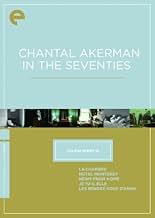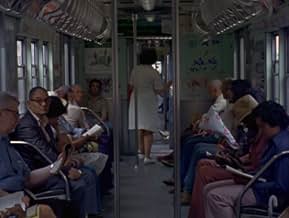News from Home
- 1976
- 1h 29min
Ajouter une intrigue dans votre langueImpersonal and beautiful images of Akerman's life in New York are combined with letters from her loving but manipulative mother, read by Akerman herself.Impersonal and beautiful images of Akerman's life in New York are combined with letters from her loving but manipulative mother, read by Akerman herself.Impersonal and beautiful images of Akerman's life in New York are combined with letters from her loving but manipulative mother, read by Akerman herself.
- Réalisation
- Scénario
- Casting principal
Avis à la une
"News From Home" gives you that chance. It isn't a movie for the average viewer, or even the average museum goer. It's introspective, spellbinding and gorgeous, given a chance. I loaned it to a friend and suggested he "let yourself go" while watching it, and he reported "it turned into magic once I let it flow through me."
If you want things that blow up, swear words, and sex, you are in the way wrong place sister. This is one of the best art films I have ever seen, without all that inaccesible interiority of so many other "art" film makers.
It's more like a personal documentary, which sounds impossible to pull off doesn't it? Well, Derek Jarman's "Blue" pales to this private gallery of scenery and emotion, which makes "News" far advanced, cuz "Blue" is my fave of his.
Chantal Akerman left her home in Brussels for New York City when she was 20 years old. She lived in NYC for three years. She made some experimental films, and then returned to Brussels. She directed her masterpiece, Jeanne Dielman, 23 quai du Commerce, 1080 Bruxelles in 1975. When she returned to NYC, she returned to her old haunts and made a movie of some of the areas in which she had lived before she was famous.
This film, News from Home, is a series of long takes of scenes in the city. It couldn't have been easy, but she managed to avoid a single striking image of the New York.
Sometimes the camera is still, and we see people walking by. Other times, we peer into deserted diners (think Edward Hopper). Sometimes she records from a moving vehicle. Other times from a subway station platform and then from inside a graffiti-tagged subway car. The last scene shows water--probably shot from the Staten Island ferry.
Think of Rick Steves New York, and then turn around 180 degrees and you get Chantal Akerman's New York. People barely notice her and her cameraperson. She barely notices them.
There's no dialog. There are traffic sounds, but apparently they were dubbed in after the movie was made. What we have instead is Akerman reading letters that her mother sent to her in the early 1970's. The content of the letters fall roughly into three parts: urging Akerman to write and complaining when she doesn't; news from home; desire of her mother that she come back to Brussels.
When Akerman reads the letters, her mother comes across as childish and somewhat pathetic. However, remember that her 20-year-old daughter is living 3,700 miles away, with no steady source of income, and without a working knowledge of English.
As a parent, I say, "Why didn't you write home more often when it meant so much to your mother?" "Why didn't you visit your uncle who lived in New York?" "Why would you want to make this movie?"
There are no breathtaking vistas in this film, so it worked well on the small screen. News from Home has a strong IMDb rating of 7.5. Here's a case where I say, "Did they see the same movie I saw?"
This film came as part of the Criterion Eclipse Series 19-Chantal Akerman in the Seventies. Besides News from Home, this three-DVD set included La Chambre (1972), Hotel Monterey (1972), Je Tu Il Elle (1975), and Les Rendezvous D'Anna (1978). I've reviewed all of them for IMDb.
It's a far piece from the world of Kenyon & Mitchell, but Akerman is not filming events where the attendees might hope to see themselves in a theater. I watched this movie and tried to figure out where each shot was taken. I think I was pretty successful. That game, however, did not take up the whole of the 85 minutes of the movie, and what was someone who was not an adult in Manhattan in the 1970s supposed to do? After ten or fifteen minutes, I decided that the audience was supposed to make of this a portrait of the recipient of the letter, an individual whose mother thinks she is hungry for news of the family, who never writes about whether she is happy or has made any friends (inference: she isn't and hasn't), and the shots are of her world in New York: first downtown near the River, then a long sojourn in the Times Square Subway Station and finally a ten-minute shot from the stern of the Staten Island Ferry setting out of Manhattan.
I think that with this movie, Akerman is trying to rewrite the relationship between film maker and audience. A film maker makes a film that tells a story, and the audience is the perceptive receiver of that tale, whether it is fiction or fact. We infer plot from the course of actions, from the changes in the personality, status, and relationships of the characters. We derive character from the way in which individual performers differ from the stereotyped roles. What, however, are we to make when you don't see the performer, don't hear her voice, except as a hurried reader of letters?
Well, the stereotypical responses fall neatly into two types. The first type says "Dagnabit! I came here to see a movie with interesting characters and a story! This is awful!" The second says "Ahah, this is new and interesting technique. I get what the auteur is trying to do, and approve, because that makes me a smarter, more percipient viewer." Which are you?
As for me, my reaction is "Interesting technique, but I'd prefer a little more effort from the film maker than forcing me to either fall asleep or make up my own story out of rags and tags." That's because I don't insist on a purely conventional story, but rather than being such an intelligent viewer that I get exactly what Akerman is trying to do, I'd like to have some character.
Then there's the other core element of 'News from home,' the voiceovers of filmmaker Chantal Akerman. As she reads letters that she had received from her mother we also get a small taste of life in Belgium at the time, and especially of the friends, family, and neighbors that Akerman herself had known. More than that - as the letters date to the period when Akerman had lived in New York, often traversing these very streets and subway lines, we are party in some measure to the relationship between her and her mother. The title becomes not just a moment captured in time of the city, but a reflection on a parent's love for their child, of wistfully missing someone who is far away, and in the very least of thinking of Home when we've gone far afield. (Or perhaps, too, a peek at the unspoken disparity between the perspectives of parent and child.) Thus is an air of fond remembrance infused into the presentation, a gentle warmth that couples neatly with the nostalgia of writing letters and the audiovisual visitations to this one time and place. The result is plainly lovely, bewitching, and even heartwarming to some degree. Why, there's almost a sense of whimsy to it all; one can readily imagine a work of fantasy or science fiction that adopts the same tack, showing us a distant world or landscape while letters from home provide a kernel of living, breathing story, whether it's a fragment of narrative or, as in this case, soft emotional context. That such feelings can be evoked by these eighty-eight minutes speaks very well to the power of cinema generally and, here, to the underappreciated genius of Akerman as a filmmaker.
I'll be honest: I love this. Plainspoken as any one-line synopsis is I didn't truly know what to anticipate, but in no time at all after I sat to watch I came to adore it. Many are the movies that have been made about someone moving to The Big City, and missing home, and all the goings-on or misadventures they might get up to in that scenario, but such fare is always embellished for effect, whether comedic or dramatic. Inasmuch as there could be a comparison to such fictional works 'News from home' is much the same concept, except it's perfectly Real and Authentic, and stirs the viewer's thoughts and feelings with that genuineness alone. Outwardly unsophisticated as the craft may be, the skill, intelligence, and care that went into it is indisputable, and the end product speaks for itself. This film is a pleasure. I vaguely assumed I'd appreciate it just for Akerman's involvement alone, and still I'm so very happy with how excellent it really is. By all means I can understand how this won't appeal to all, though as far as that goes the premise should be all the fair warning needed to turn away those who aren't receptive. Yet for viewers who enjoy the quiet, thoughtful side of the medium, or those who find joy in the mundane, I can't overstate what a great treasure this is. 'News from home' is a sublime picture that strikes a rather unique but meaningful chord, and I'm glad to give it my very high, hearty recommendation.
Le saviez-vous
- AnecdotesWhen Akerman's mother writes her father lost 300,000 francs due to a client's bankruptcy, that would equate to about $8,300 at the time or $38,100 in 2019.
- Citations
Herself - Letter Reader: I received your screenplay. It's well-written, but you know my taste: I find it sad and gloomy. Those people sure have a hard life. It's an important social issue. I hope it will turn out well. The public must be made aware of all this suffering that you young people see so clearly.
- ConnexionsFeatured in What to Watch: Cate Blanchett's Films of Hope (2020)
Meilleurs choix
- How long is News from Home?Alimenté par Alexa
Détails
- Date de sortie
- Pays d’origine
- Langue
- Aussi connu sous le nom de
- Briefe von zu Haus
- Lieux de tournage
- Veselka Restaurant, 144 2nd Ave, Ville de New York, New York, États-Unis(newstand outside with awning in Ukrainian)
- Sociétés de production
- Voir plus de crédits d'entreprise sur IMDbPro
- Durée1 heure 29 minutes
- Mixage
- Rapport de forme
- 1.37 : 1
Contribuer à cette page























